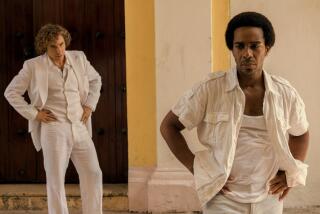Review: ‘Biggie: I Got a Story to Tell’ reveals another side of the late Notorious B.I.G.
- Share via
The hip-hop artist known as the Notorious B.I.G. was tagged back in the mid-’90s as a “gangsta rapper.” But the people who knew him best remember him more as a musical explorer and a phenomenal live performer, who — if he hadn’t been killed at age 24 — might’ve eventually transcended any genre, fusing hip-hop, vintage soul, cutting-edge pop, rock, country and more. Beneath his imposing surface, Christopher “Biggie Smalls” Wallace had a lot of interests, and a lot on his mind.
The goal of the Netflix documentary “Biggie: I Got a Story to Tell” is to change some of the conventional wisdom on Wallace, moving beyond his semiautobiographical tales of crime and cash. Director Emmett Malloy has interviews with a lot of Biggie’s oldest friends, along with rare home video footage of him as a teenager. What emerges from the film is a portrait of an artist who was always honest about his life on the streets — but who ultimately was perhaps too defined by what he did to make money when he was a kid.
One of the best creative choices Malloy makes is to cut occasionally to an animated map of New York City, showing the boundaries of the young Wallace’s world. Raised by a single mother — a Jamaican immigrant who worked as a schoolteacher — Wallace spent most of his time as a boy hanging out on just a few blocks in Brooklyn, including an infamous street run by drug dealers.
While he and his friends were selling crack as teenagers, Wallace was also obsessing over hip-hop, honing a lyrical flow that struck anyone who heard it as incredibly advanced, with its internal rhymes and repetition. As soon as he started recording, he was a star, renowned for the fatalistic frankness of his songs about drugs, violence and thwarted dreams. The Notorious B.I.G.’s 1994 debut album “Ready to Die” became an instant classic.
Because Malloy covers so much of the lesser-known part of Biggie’s story, he falls a bit short when setting up the final two years of the rapper’s life. There’s a lot of talk about what set Wallace’s early songs apart, but not as much analysis of why “Ready to Die” connected so quickly. And the beef between East Coast and West Coast rappers that eventually led to Biggie’s shooting gets only brief, sketchy coverage here.
This seems to be a conscious choice on Malloy’s part, to minimize the tragic falling-out between the Notorious B.I.G. and the hip-hop legend Tupac Shakur — a story told many times before in other documentaries and dramatizations.
Instead, this movie is less about the myth of Biggie than it is about the everyday experiences of a man described by his friends as much funnier and more big-hearted than his public image sometimes suggested. Despite the title, “I Got a Story to Tell” is primarily concerned with all the tales that went untold.
'Biggie: I Got a Story to Tell'
Rated: R, for pervasive language and drug content
Running time: 1 hour, 37 minutes
Playing: Available on Netflix
More to Read
Only good movies
Get the Indie Focus newsletter, Mark Olsen's weekly guide to the world of cinema.
You may occasionally receive promotional content from the Los Angeles Times.










